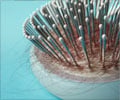A new human skin map reveals the "recipe" to rebuild skin, offering potential for preventing scarring and advancing skin regeneration treatments.

A human prenatal skin cell atlas reveals immune cell regulation of skin morphogenesis
Go to source) In the study, published in Nature, the team also created a ‘mini organ’ of skin in a dish with the ability to grow hair. Using the organoid, they showed how immune cells play an important role in scarless skin repair, which could lead to clinical applications to prevent scarring after surgery, or scarless healing after wounding.
‘Imagine regrowing #hair follicles to treat #burnscars or #alopecia. The new research could be the key to unlocking #regenerativemedicine for hair and skin. #hairgrowth ’





As part of the Human Cell Atlas, which is mapping all cell types in the human body to transform understanding of health and disease, the researchers provide a molecular ‘recipe’ to build skin and a new organoid model to study congenital skin diseases. Skin is the largest organ of the human body, measuring on average two square metres. It provides a protective barrier, regulates our body temperature and can regenerate itself. Skin develops in the sterile environment of the womb, with all hair follicles formed before birth – there is follicle cycling after birth, but no new follicles are made. Before birth, skin has the unique ability to heal without scarring.
It has been very difficult to study how the human skin develops, as animal models have key differences. As part of the Human Cell Atlas, a team of researchers is focused on studying how human skin is built. Understanding how skin develops, where cells are in space and time, and the role of genetics will help reveal how specific mutations cause congenital skin disorders, such as blistering disorders and scaly skin.
In this new study, researchers at the Wellcome Sanger Institute, Newcastle University and their collaborators created the first single cell and spatial atlas of human prenatal skin.
The team used samples of prenatal skin tissue, which they broke down to look at individual cells in suspension, as well as cells in place within the tissue. Scientists used cutting-edge single-cell sequencing and spatial transcriptomics to analyse individual cells in space and time, and the cellular changes that regulate skin and hair follicle development. They described the steps that outline how human hair follicles are formed and identified differences from mouse hair follicles.
Advertisement
The team found that blood vessels did not form in the skin organoid as well as prenatal skin. By adding immune cells known as macrophages to the organoid, they discovered the macrophages promoted the formation of blood vessels, and the team undertook 3D imaging to assess blood vessel formation within the tissue.
The team also analysed differences in cell types between prenatal skin and adult skin. They show how macrophages play an important role in scarless skin repair in prenatal skin, which could lead to clinical applications to avoid scarring after surgery or wounding.
As a result of this study, the team provides a molecular ‘recipe’ for how human skin is built and how hair follicles form.
The prenatal human skin atlas will also be used to identify in which cells the genes are active, or expressed, that are known to cause congenital hair and skin disorders, such as blistering disorders and scaly skin. The researchers found that genes involved in these disorders are expressed in prenatal skin, meaning they originate in utero. The skin organoids created in this study offer a new, accurate model for studying these diseases.
Dr. Elena Winheim, co-first author from the Wellcome Sanger Institute, said: “With our prenatal human skin atlas, we’ve provided the first molecular ‘recipe’ for making human skin and uncovered how human hair follicles are formed before birth. These insights have amazing clinical potential and could be used in regenerative medicine, when offering skin and hair transplants, such as for burn victims or those with scarring alopecia.”
Dr. Hudaa Gopee, co-first author from Newcastle University, said: “We’re excited to have made a skin organoid model that grows hair. In this process, we uncovered a new, important role of immune cells in promoting the growth of blood vessels in developing skin tissue, which could help improve other organoid models. These immune cells, called macrophages, also appear to play a key part in scarless skin repair in prenatal skin. Our findings could inform clinical advances to avoid scarring after surgery.”
Professor Muzlifah Haniffa, co-lead author and Interim Head of Cellular Genetics at the Wellcome Sanger Institute, said: “Our prenatal human skin atlas and organoid model provide the research community with freely available tools to study congenital skin diseases and explore regenerative medicine possibilities. We are making exciting strides towards creating the Human Cell Atlas, understanding the biological steps of how humans are built, and investigating what goes wrong in disease.”
Reference:
- A human prenatal skin cell atlas reveals immune cell regulation of skin morphogenesis - (https://www.nature.com/articles/s41586-024-08002-x)















